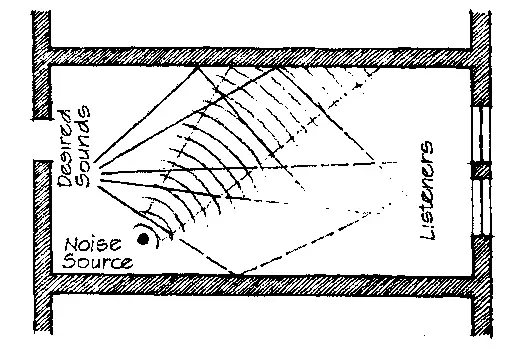
The following is a brief collection of terms related to the design of sound control in buildings.
The primary concerns in sound control for building designers are:
- Room Acoustics – Controlling the experience of sounds within an enclosed space.
- Sound Privacy – Keeping sound enclosed within a given area.
- Noise Control – Preventing undesired sound.
Contents
- A-Scale
- Absorbers
- Absorption
- Acoustical Privacy
- Acuity
- Ambient
- Amplitude
- Attenuation of Sound
- Barrier (Sound)
- Complex Waves
- Concave
- Conductor
- Convex
- Criteria
- Crosstalk
- Cycle
- Damping
- Decibel (dB)
- Density
- Diaphram
- Diffraction
- Diffuse
- Displacement
- Dominant Pitch
- Dyne
- Elastic
- Energy
- Flanking
- Flanking Transmission
- Frequency
- Fundamental Frequency
- Harmonics
- Hertz (Hz)
- Homogeneous
- Impact Insulation Class (IIC)
- Intensity
- Masking (Sound)
- Mitigation
- Murphy’s Law
- Noise
- Noise Reduction Coefficient (NRC)
- Octave
- Octave Band
- Overtones
- Party Wall
- Pitch
- Plenum
- Pressure Waves
- Radiate
- Resilient Attachment
- Resonance
- Reverberation
- Sabin
- Sound
- Sound Attenuation
- Sound Conditioning
- Sound Leak
- Sound Pressure
- Sound Propogation
- Sound Transmission
- Structure-Borne Sound (Noise)
- Subjective
- Symmetrical
- Timbre
- Tone
- Variable
- Velocity
- Vibration
- Watt
- Waveform
- Wavefront
- Wavelength
A-Scale
Reference intended to match the response characteristics of the average human listener. called dBA.
Absorbers
Materials that have the capacity to absorb sound, such as acoustical tile and panels, carpeting, draperies, and upholstered furniture.
Absorption
Taking up and holding or dissipating of matter or energy as a sponge takes up water. Absorption is the opposite of reflection.
Acoustical Privacy
State of sufficient insulation (protection) from intruding and disturbing noise.
Acuity
Relative clarity (sharpness, keenness) of sound communication.
Ambient
Existing surrounding conditions. Ambient noise level refers to the existing conditions in a space as a result of enduring sounds from all sources.
Amplitude
Measurement of sound level in wavelength terms.
Attenuation of Sound
Reduction of sound energy as it passes through a conductor, resulting from the conductor’s resistance to the transmission.
Barrier (Sound)
Structure that impedes direct sound transmission
Complex Waves
Sound waves combining two or more frequencies
Concave
Curved toward the observer. Cupped.
Conductor
Material that carries or transmits energy from one location to another. A conductor of sound must be an elastic material.
Convex
Curved away from the observer. Rounded.
Criteria
Standards by which performance can be judged.
Crosstalk
Two-way exchange of sounds between spaces through a connecting sound path. Usually a flanking or leaking path (connecting ducts, pipe chases, back-to-back wall fixtures, etc.).
Cycle
One complete phase of an action, such as one revolution of a wheel or one full swing of a pendulum.
In relation to sound, one to-and-from movement of the vibrating object or one high-low pressure sequence of a sound wave.
Damping
Effect that reduces the amplitude of a vibration
Decibel (dB)
Unit adopted for the convenience in representing vastly different sound pressure.
It is 20 times the logarithm to the base 10 of the ratio of the sound pressure to a reference pressure of 0.0002 dyne/cm^2.
This reference pressure is considered the lowest value that the ear can detect.
Density
Ratio of the mass (or weight) of a body to its volume. A common unit of measure is pounds per cubic foot.
Diaphram
Thin body that separates two areas. In sound, the skin of a partition or ceiling that separates the room from the structural space in the center of the partition of ceiling assempbly.
Diffraction
Change in direction that occurs when a wave contacts a space, surface, or edge smaller than the wavelength.
Diffuse
To spread out evenly and thus become less dense or concentrated.
Displacement
Forced movement away from an original location.
Dominant Pitch
Subjective response of the ear to the fundamental frequency of a sound. Usually louder tahn the harmonic overtones and of lower frequency.
Dyne
Unit of force. Specifically, the force required to accelerate one gram of mass one centimeter per second.
Elastic
Capacity to return to original shape after deflection.
Energy
Ability to perform work. In sound, the capacity to compress the conductor of molecules.
Flanking
Taking a path around something, such as a sound barrier.
Flanking Transmission
Transmission of sounds by indirect paths; around, rather than through, intervening barriers.
Frequency
Number of times than an action occurs in a given time period.
In sound, the number of complete vibration cycles per second represented by the unit hertz (Hz).
Fundamental Frequency
Dominant and usually lowest frequency of a sound which establishes the frequencies of the harmonics.
Harmonics
Secondary frequencies that are whole-number multiples of the fundamental frequency of a sound.
The harmonics combine with the fundamental frequency to produce the complex sound wave, giving timbre or quality to the total sound as perceived.
Hertz (Hz)
Unit of measure of frequency, representing cycles per second.
Homogeneous
Of uniform composition and structure.
Impact Insulation Class (IIC)
Whole, positive number rating, based on standardized test performance, for evaluating the effectiveness of assembles in isolating impact sound transmission.
Intensity
Rate of sound energy passing through a unit of area.
Masking (Sound)
Added sound that increases the background noise level to reduce perception of incoming noises.
Mitigation
Reduction of the effect of something (general definition).
Murphy’s Law
Anything that can go wrong will go wrong.
Noise
Undesired sound; usually of a disturbing nature or causing interference with some hearing task.
Noise Reduction Coefficient (NRC)
Mathematical average of sound absorption coefficients recorded at the frequencies of 250, 500, 1000, and 2000 Hz.
Octave
Interval between a sound of one frequency and a sound with a frequency that is exactly double the first.
Octave Band
Frequency spectrum that is one octave wide.
Bands of one-third octave are used for recording sound test results and are designated by the center frequency of the band.
Overtones
Subjective response of the ear to harmonics.
Party Wall
Wall or partition separating two occupancies in a building.
Pitch
Highness or lowness of a sound as perceived by the ear.
While the frequency of the sound determines the highness, pitch is the subjective response to it.
Plenum
Enclose air space.
Pressure Waves
Layers of high and low pressure that radiate out in all directions from a sound source.
Radiate
To travel in straight lines away from a center, such as sound waves moving out from a source.
Resilient Attachment
Fastening system that reduces the transmission of vibrations.
Resonance
Sympathetic vibration of an object when subjected to a vibration of a specific frequency.
The object tends to act as a sound source.
Reverberation
Continuation of sound reflections within a space after the sound source has ceased.
Sabin
Unit of measure of sound absorption; the amount of sound absorbed by a theoretically perfect absorptive surface of 1 square foot area.
Named for Wallace C. W. Sabine, noted American physicist.
Sound
For our purposes: what is received by human listeners through the physiological process of hearing.
Sound Attenuation
See Attenuation of Sound.
Sound Conditioning
Designing and equipping a space for faithful retention of desirable sounds and maximum relief from undesirable acoustical effects.
Sound Leak
Hole or crack that permits sound to pass through a separating barrier (wall, floor, roof).
Sound Pressure
Instantaneous change in pressure resulting from vibration of the conductor in the audible frequency range.
Conversational speech at close range produces a sound pressure of about 1 dyne per square centimter.
Sound Propogation
Origination and transmission of sound energy.
Sound Transmission
Transfer of sound energy from one place to another, through air, structure, or other conductor.
Structure-Borne Sound (Noise)
Sound imparted directly to and transmitted through the building construction.
Subjective
Related to conditions of the brain and sense organs rather than to direct physical actions/
Symmetrical
State of being identical or balanced on each side of a real or imaginary dividing line.
Timbre
Subjective response of the ear to the quality or richness of a sound, produced by the number and relative energy of the harmonics and other frequencies present in the sound.
Tone
Subjective response of the ear to the pitch of a sound.
Variable
Value that changes with changes in the conditions.
Velocity
Rate of travel.
Vibration
Uniform, rapid movements of an elastic material in a back-and-forth direction.
Watt
Unit of power. Sound pressure intensity can be directly measured in watts/cm^2 or in dynes/cm^2.
Waveform
Shape of the graphic representation of a sound wave.
Wavefront
Spherical surface of the wave as it travels out in all directions from the source.
Wavelength
Physical distance between identical points on successive waves. The wavelength is a function of the frequency and the speed of sound in the conductor.

